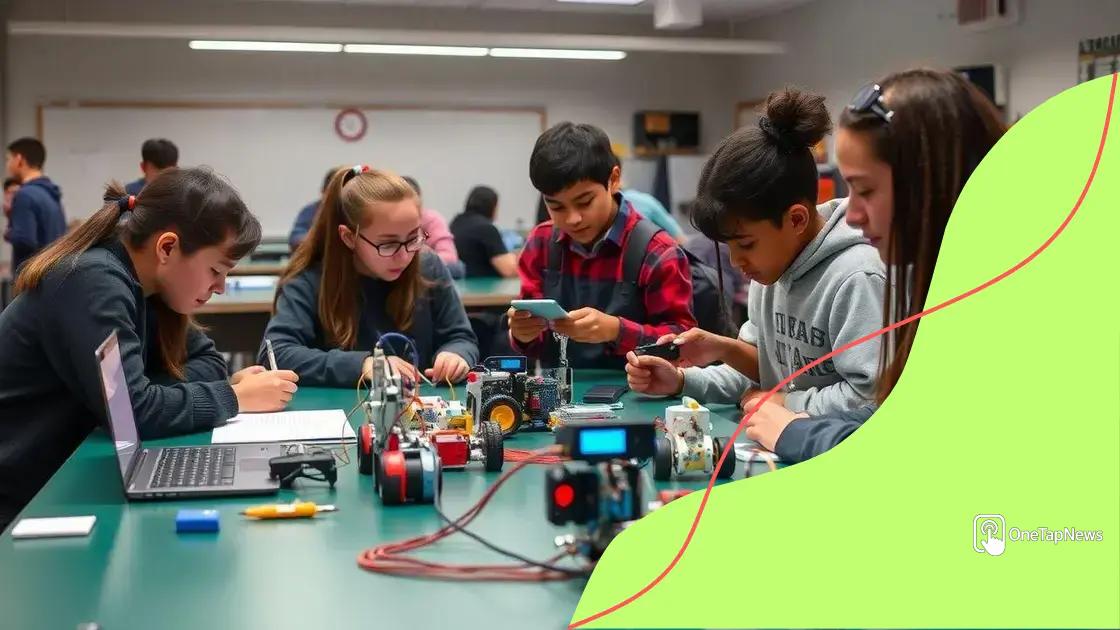Developing computational thinking abilities for lifelong skills

Anúncios
Developing computational thinking abilities enhances problem-solving skills, logical reasoning, and creativity, making it essential for students in today’s technology-driven education system.
Developing computational thinking abilities is more than just a trend in education; it’s a necessity. Have you ever wondered how these skills can change problem-solving in daily life? In this article, we will delve into its significance and practical uses.
Anúncios
Understanding computational thinking
Understanding computational thinking is essential for navigating the complexities of today’s world. It’s not just about coding or programming; rather, it involves solving problems effectively and creatively. This skill develops as you engage with various activities, helping you approach challenges from different angles.
Defining computational thinking
At its core, computational thinking is a way of thinking that enables individuals to solve problems systematically. It combines concepts from computer science with core problem-solving methods. Here are some key aspects to understand:
- Decomposition: Breaking down a problem into smaller, manageable parts.
- Pattern recognition: Identifying trends or similarities within problems to find solutions.
- Abstraction: Focusing on the essential details while ignoring irrelevant factors.
- Algorithms: Developing step-by-step instructions to solve problems.
Each of these components plays a critical role in shaping one’s ability to think computationally. The best part is that anyone can learn these skills through practice and application.
Anúncios
Why is it important?
The importance of computational thinking extends beyond traditional computer science fields. It is a valuable skill applicable in everyday life, enhancing our ability to make informed decisions and solve real-world problems. As we engage more with technology, these skills empower us to understand and leverage digital tools effectively.
For example, consider how we approach daily tasks like shopping or planning a trip. By applying computational thinking, we evaluate options, make lists, and prioritize our actions systematically. This analytical mindset fosters efficiency and clarity, streamlining our decision-making process.
In educational settings, fostering computational thinking equips students with vital skills needed for future careers. By integrating these principles into the curriculum, educators can prepare students to face complex challenges head-on. This preparation ultimately leads to a more adaptable and innovative workforce.
The importance of computational thinking in education
The importance of computational thinking in education is gaining recognition as a vital skill for students. This approach encourages learners to develop critical skills that are applicable in various domains. By integrating computational thinking into the curriculum, educators can foster problem-solving abilities that go beyond traditional subject boundaries.
Preparing students for the future
As technology evolves, so does the need for skills that enable students to navigate a digital world. Computational thinking equips students with essential tools to tackle complex tasks efficiently. Educators can create an environment that promotes innovation and creativity through engaging projects and collaborative efforts.
- Enhances problem-solving skills: Students learn to break down large problems into smaller, manageable parts.
- Encourages logical reasoning: This skill develops structured thinking and empowers students to make informed decisions.
- Fosters teamwork: Group activities allow students to collaborate and learn from one another.
- Builds persistence: Students develop resilience as they learn to tackle challenges systematically.
Moreover, incorporating computational thinking in education allows students to connect concepts from different subjects. For instance, they can apply mathematical principles in programming or use science to create algorithms in engineering projects. This interdisciplinary approach enriches their overall learning experience.
Real-world applications
Incorporating computational thinking in educational practices prepares students for real-world challenges. They can apply these skills in various fields, including software development, medicine, and even the arts. Understanding how to analyze data, develop algorithms, and reason logically enables them to contribute significantly to society.
Furthermore, as industries continue to embrace digital transformation, a strong foundation in computational thinking sets students apart in the job market. They become adaptable and resourceful problem solvers, ready to face the upcoming technological shifts.
Techniques to enhance computational thinking

There are several effective techniques to enhance computational thinking, which can lead to better problem-solving and creativity in learners. By incorporating these strategies into education, teachers can help students develop essential skills that are applicable in many areas.
Interactive Learning Experiences
Using interactive activities can significantly boost a student’s understanding of computational thinking. Games and simulations create engaging environments that encourage exploration and decision-making. These activities help students visualize complex problems and practice their skills in real-time.
- Robotics: Building robots can enhance understanding of algorithms and logic.
- Game Design: Creating games allows students to apply coding skills creatively.
- Problem-Solving Challenges: Engaging in puzzles fosters logical reasoning.
- Collaborative Projects: Working in groups builds teamwork and communication skills.
These methods create opportunities for hands-on learning, enabling students to relate theory to practice and fostering a deeper understanding of the content.
Incorporating Technology Tools
Technology tools greatly enhance the teaching of computational thinking. Utilizing educational software and coding platforms, teachers can provide students with access to resources that promote skill development. By integrating these tools into the curriculum, students can learn at their own pace and explore various concepts in-depth.
For instance, using platforms like Scratch or Code.org allows students to create multimedia projects that express their understanding of algorithms and logic. Additionally, coding apps can make practicing coding concepts fun and engaging.
Students also benefit from learning how to use data analysis tools, which help them make sense of information and prepare them for real-world applications. Understanding how to interpret data can be a powerful skill in today’s data-driven society.
Real-world applications of computational thinking
Real-world applications of computational thinking are vast and can be seen across various professions and everyday scenarios. This skill set allows individuals to approach problems logically and efficiently, making it a critical asset in today’s technology-driven society.
Problem Solving in Everyday Life
One of the most significant applications of computational thinking is enhancing everyday problem-solving abilities. Whether planning a trip, organizing a schedule, or troubleshooting a device, individuals use computational thinking without even realizing it. By breaking down these tasks into smaller parts, people can better manage and complete them.
- Scheduling: Creating efficient timetables involves prioritizing tasks and allocating time wisely.
- Home Improvement: When fixing things around the house, assessing the problem, gathering tools, and executing a plan reflects computational thinking.
- Budgeting: Managing finances requires logical reasoning and analysis of spending patterns.
- Research: Gathering information and comparing options helps in making informed decisions.
These examples show how core elements of computational thinking are ingrained in our daily lives, enabling us to tackle challenges more effectively.
Career Opportunities
In the job market, understanding computational thinking gives candidates a competitive edge. Many industries rely heavily on this skill, from technology to healthcare. Professionals use computational thinking to analyze data, develop software, and create solutions to complex problems.
For instance, software developers break down large projects into manageable components, while data analysts interpret trends and make predictions. In healthcare, specialists apply computational thinking to improve patient care by analyzing data and optimizing treatment plans.
Furthermore, fields like marketing use analytical skills rooted in computational thinking to develop effective strategies based on consumer behavior. This shows that the value of computational thinking extends beyond technical roles and into diverse career paths.
Challenges in teaching computational thinking
Teaching computational thinking comes with its own set of challenges. Educators often face obstacles that can hinder the effective implementation of these skills in the classroom. Understanding these challenges helps in finding solutions to overcome them.
Lack of Familiarity
One significant challenge is the lack of familiarity with computational thinking among teachers. Many educators may not have received training in this area, making it difficult for them to confidently teach these concepts. Professional development programs focused on computational thinking can help teachers gain the necessary skills.
- Training Opportunities: Providing teachers with workshops and resources.
- Peer Learning: Encouraging collaboration among educators to share knowledge.
- Online Courses: Offering accessible learning options for busy teachers.
- Mentorship Programs: Pairing experienced instructors with those new to the field.
These strategies can support teachers in becoming more comfortable with teaching these essential skills.
Curriculum Integration
Another challenge lies in integrating computational thinking into existing curricula. Often, educators have limited time to cover extensive content, which may lead to a focus on traditional subjects. Balancing curriculum demands while incorporating these skills can be daunting.
Educators need to find ways to blend computational thinking into the subjects they already teach. For instance, mathematics lessons can include logical reasoning and problem-solving exercises, while language arts classes can incorporate coding concepts through storytelling.
Collaboration among subject-area teachers can foster interdisciplinary approaches. Such collaboration promotes a holistic learning environment, where students can see the connections between subjects.
Student Engagement
Lastly, keeping students engaged when learning computational thinking can be challenging. Some students may feel overwhelmed by technology or disinterested in critical thinking tasks. Creating enjoyable and interactive learning experiences can help to counteract this issue.
Utilizing games, hands-on projects, and real-world applications of computational thinking can spark interest. Students are more likely to engage with content that feels relevant to their lives and interests.
Conclusion:
In summary, teaching computational thinking is essential in today’s education. While there are challenges, such as teacher familiarity and curriculum integration, these can be addressed with effective strategies. By enhancing student engagement and utilizing interactive learning experiences, we can equip students with skills essential for the future. As we move forward, it is crucial to foster an environment that embraces computational thinking across various subjects and real-world applications.
FAQ – Frequently Asked Questions about Computational Thinking in Education
What is computational thinking?
Computational thinking is a problem-solving process that involves breaking down complex problems into manageable parts, identifying patterns, and developing algorithms.
Why is computational thinking important for students?
It equips students with essential skills like logical reasoning and problem-solving, which are applicable in various fields and everyday life.
What challenges do teachers face in teaching computational thinking?
Teachers may lack familiarity with the concepts, struggle to integrate it into the curriculum, and find it challenging to keep students engaged.
How can schools enhance computational thinking skills?
By providing training for teachers, integrating it into existing subjects, and using interactive learning methods like games and projects.